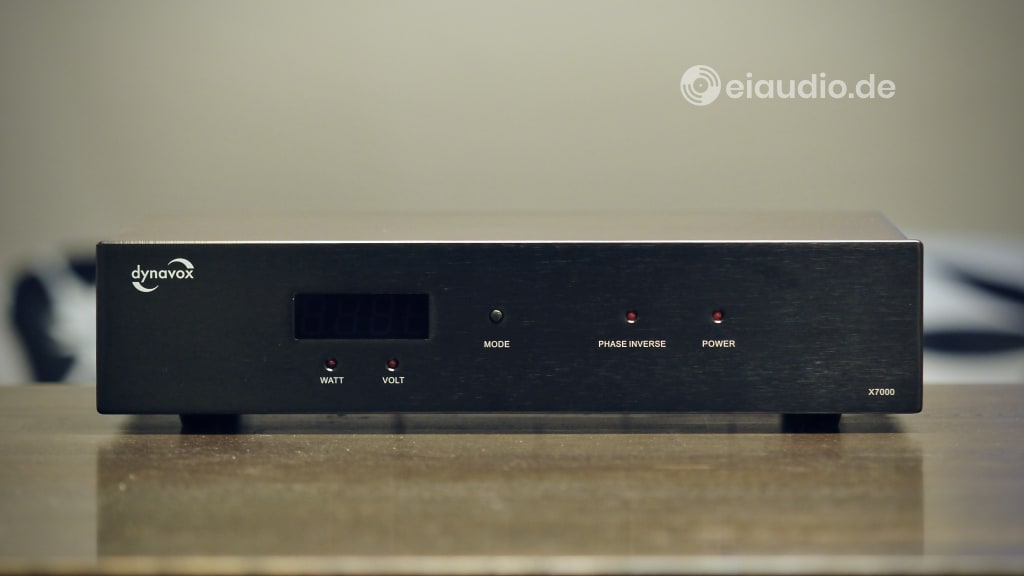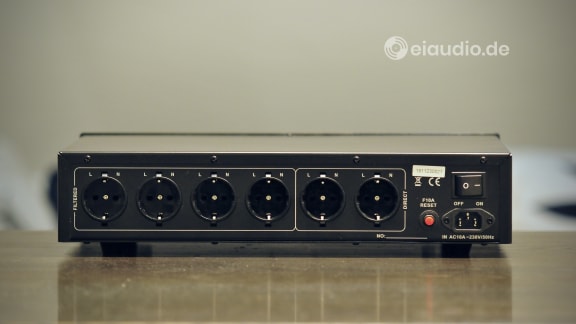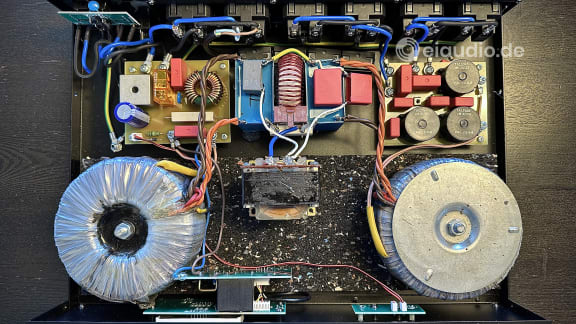30. High-End Network Noise Filter
Published: 21/02/2023
Author: Karsten Hein
Category: High Fidelity
Sintron Distribution GmbH sells a whole range of affordable gear under the name of Dynavox to target entry-level audiophiles. Among the many worthwhile components, there is the VR-70E II tube amplifier that, with some minor amount of tweaking, performed very well in our listening setup. The Dynavox brand name can also be found on audio accessories such as cables, plugs, and power distributors both with and without filter technology. The Dynavox X7000, which lent its components to the construction of the High-End network filter that is the subject of discussion here, had most likely been a capable power conditioner to begin with. However, the aim of this construction project was to take filtration technology to the next level.
My first exposure to the High-End network filter project was on one of my routine visits to my trusted audio technician. As I walked into his shack, I could see him applying a string of ferrite beads to a freshly laid power cable inside the Dynavox X7000’s housing. I was surprised by the amount of free space inside the large X7000 cabinet, and Winfried explained that the original filter design had only taken up about a hand’s breadth of room inside the 43cm wide enclosure. And yet, the unit was large enough to hold far more sophisticated filters and even allowed for the use of isolating transformers. Winfried further explained that Dynavox’s use of high-quality materials on the cabinet, sockets, and switches made it the ideal basis for his new construction.
This must have been in early 2020, and it was not until two years later that I asked Winfried what had become of his High-End network filter design. He seemed pleased about my asking and offered to lend it to me for a few days so that I could find out for myself. He explained that he had galvanically separated the audio circuit from the household grid through isolating transformers allowing for 300 watts of throughput power. When seen from the rear of the unit, looking from left to right, there were two power sockets filtered for analog music sources, two power sockets intended for digital music sources, and two sockets without filters. On the power input side, a number of ferrite beads served to prevent high frequency noise from passing through the interior circuits.
Winfried’s new power filter stages were designed to target the anharmonic frequencies of 50 Hz. These were at 150 Hz, 250 Hz, 350 Hz, 450 Hz, etc. The filters became more effective the higher the anharmonic frequency was. Distortion measurements conducted by an independent laboratory found the filter strength to be 60 dB at 1,000 Hz and 90 dB at 10,000 Hz. These were very good results for any power conditioner. In addition to this, Winfried’s High-End network filter provided DC protection through a combination of bridge rectifier and capacitor and also maintained the original voltage control display that could be switched off for maximum noise protection. The touch and feel of the finished unit was great. It felt as if it had been carved out of a solid piece of metal, an effect that was supported by its weight.
Back in our upstairs listening room, I connected the filter to the same wall outlet that had already proven itself as being relatively free of distortion on our existing system. As we lived in an apartment building that was a home to four families and located in a mixed residential and industrial area, all observations on the electrical noise floor were relative and subject to change, depending on the day of the week, the time of day, and the number of other household devices that were active on the grid. In addition to this, our house was located within a five kilometre radius from the airport and about 800m beeline from the local tram and train lines. On clear days, we also had unobstructed view of the radio tower on Feldberg and the airport’s revolving radar with visual signal light—not to mention the many cellphone antennas that were perched on nearby buildings.
To filter out the cacophony of electric noises on our power grid was the proclaimed job of Winfried’s network filter. Where, if not here, could a device of this kind prove its merits? — I connected our Rotel RC-960BX preamplifier to the power output that was designed for analog devices and our Denon DCD-1420 CD player to the power output for digital devices. Both of the sources were considered solid entry-level components. I then connected my custom-built Echle LF-3519 solid state amplifier directly to the wall outlet and warmed up the system. The first thing I heard was a mild buzzing sound emanating from the filter’s large transformers, followed by the by now familiar noise floor from the high-gain amplifier. I was a little disappointed that the amplifier’s noise floor did not drop significantly with the filter attached. Sadly, this did not change even when I connected the amplifier directly to the unfiltered output of Winfried’s power conditioner.
I chose a-ha’s 2017 MTV Unplugged album “Summer Solstice” as listening sample, as it was a solid live recording with natural instruments, spoken and sung male and female vocals, and a small venue audience that could sound believable in our listening room. Songs like ‘This is our home’ provided a bass drum impression that allowed for a good sense of proportion, attack, and decay. Listening with the filter in place, I noticed that stereo imaging was much improved. ‘This is our home’ begins with a spoken introduction in which the first speaker is sitting further to the left. Without the filter, the two musicians appeared to be speaking from the same position. There also seemed to be more space around the instruments with the sound stage panning further and more seamlessly from left to right. The position of the audience seemed more realistic with fewer holes in the sound stage.
Power plug polarity had a major effect on the overall sound signature. This came as a surprise to me, as I would have expected the network filter to have a harmonising effect between the units. Without the filter in place, it was immediately clear to me which plug polarity was my preference. However, this was not so easy for me to decide with the filter in place. In one plug combination the sound became lighter and more airy and in another darker and tonally richer. I would normally have preferred the second, as it offered a stronger mid bass and a weightier and fuller sound, if it had not been for an increased amount of grain in the midrange that made vocals slightly less believable. No matter how much I tried different plug combinations, I was always left between those two choices: darker and more voluptuous with slight grain on the vocals or light and airy without the grain. But which one was correct?
Listening to music without the filter again, I noticed that tonality remained slightly shifted upward towards light, airy, and slightly sharp in the treble. Bass notes were lacking a little energy and could not free themselves so much. My preference would have been to keep the filter in place, and to set plug polarity to produce the darker tonality but without the slight sense of grain. This, however, was a result that I failed to reach on our system. I decided to report my findings back to Winfried, hoping that he could further help me in understanding the unit and the effect I had found. — Audiophiles are a tough species to satisfy, I suppose.
< 4. Power Filtering | Dynavox Tube Amp (Part II) >
Specifications
- Type: 240 volts power isolator and filter
- Isolation principle: galvanic separation
- Features: soft-start (to offset transformer magnetisation)
- Filter principles: low-frequency harmonics and HF noise
- Filter frequencies: 150 Hz / 250 Hz / 350 Hz / 450 Hz (anharmonic)
- Filter strength: 60 dB (@1,000 Hz); 90 dB (@10,000 Hz)
- DC-filtration principle: bridge rectifier and capacitor
- Throughput power (max.): 300 VA
- Power sockets (switched): 2x analog, 2x digital, 2x direct
- Switchable display (on/off): mains voltage input, LCD (amber)
- Cabinet basis: Dynavox X7000 Power Conditioner
- Dimensions: (W) 430mm x (H) 100mm x (D) 305mm
- Country of manufacture: Germany (custom-made)
- Weight: 18.5 kg
- Year(s): 2020 - 2023




